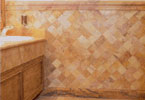|
 |
 |
 |
 |
 |
 |
 |

Giallo Antico  The kedhel
The kedhel  Berber & black black Aziza
Berber & black black Aziza
The Majus Green
With ARTEMIS,
we carry out our works starting from selected marbles,
extracted often in an artisanal way of the old careers
of the Roman empire.
 |
Giallo Antico |
| 
|
The legend
wants that Carthage was founded by the mythical
queen phenician Didon, three thousand years ago.
Annexed by Rome at the first century before our
era, Carthage becomes third city of the empire. |
|
During
these centuries, the Roman domination marked this
Provincia Africa and generated powerful buildings
with the imposing marmoreal columns and the ground
covered with mosaics, thus illustrating the opulent
life and the ease of their hosts.
In the depths of Provincia, the Romans had discovered
a rare mineral which could flatter their residences.
If the sovereign whiteness of the Carrara marble
had allured the emperors, the latter were quite
as sensitive to Giallo Antico de
Chemtou, marble as invaluable as the porphyry
which offers a range of tone and nuances of colors
going from gilded to the ivory. Its dominant veined
degraded yellows of pink were going to allow a
large variety of decorations in glorious monuments
that they were going to set up, not only in Roman
Africa, but also in the theatres of Oranges and
Arles, the villa of Adrien at Tivoli or the gymnasium
of Adrien in Smyrna.
But the source of this mythical Giallo Antico
ends up drying up. Rexploited then and forgotten
again at the XIX 2nd century, the careers reappear
today with a new life thanks to founders of ARTEMIS.
This rediscovery gives again life with the past;
many artists and craftsmen recreate since superb
marquetries which made the splendour of the Roman
grounds. The architects and decorators integrated
them into their achievements: grounds of mosaics,
tables of marble marquetry, compositions alternating
terra cotta and marbles in subtle mixtures.
Today, Giallo Antico is extracted
in an artisanal way and with economy of an imperial
career Romaine with Chemtou in north of Tunisia
at coast of the ancient city of Bulla Regia, famous
for his underground houses.
With ARTEMIS,
we employ Giallo Antico in carved
works (columns, pilasters, basins, wash-hand basins,
small sculptures, etc.) but also for the development
of coatings,
in the calepinage
and the mosaïque.
 |
Kedhel |
 |
The keddel
is one of these rocks which do not miss decorative
qualities and which knew a special favour
in the Roman and tunisoises construction.
|
| The
careers of Kedhel are located
at Grombalia in the south suburb of Tunis.
The production in Kedhel was
very diversified; architectural elements
(blocks, barrels, bases, capitals, sarcophagi),
decorative elements, usual inscriptions,
objects, all these forms were curved in
blocks of very diverse size.
Nowadays, the production of platings and
coatings in Kedhel take place.
These coatings in Kedhel are
produced with various completions (glossed,
aged or sanded) which always seek to preserve
the aspect and the natural charm of this
stone.
|
 |
Black Berber & Black
Aziza |
It was the black
marble more appreciated by antiquity for its
hardness and its resistance. Its fine and
compact grain forms a black bottom contrasting
with veins of a pure white, rusts or tender
pink.
|
 |
The Majus Green |
| This
green marble remained since antiquity practically
unknown and little used. The reduced size
of the layers allows only one artisanal extraction
of low-size blocks. It has the hardness of
the granity, a fine and dense screen. |
| Its heat green olive
color with the transparencies of the dark
funds often enriched by veins brown dark and
rust; the clear funds resemble watercolour
paintings. |
|
|
|
 |
|